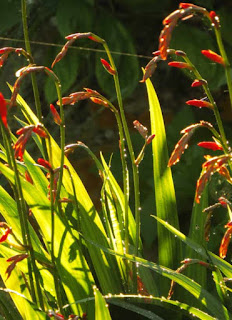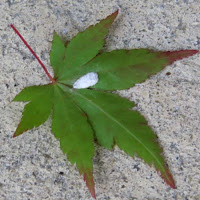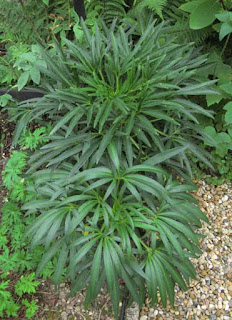"Modest plants can mean as much to me
as their flamboyant neighbours."
- Beth Chatto
 |
| Soft early light making the crocosmia glow |
When gardening in a hotter climate, it's tempting to grow as many new and exotic flowers as you can find, to establish a complete change of palette from the subtle greys and greens of the British Isles.
 |
| Crocosmia 'Emily McKenzie' - a touch of the tropics |
But, as Beth Chatto points out when talking about the merits of choosing sedums, "Too many star performers lumped together can become quarrelsome".
We've picked a few fiery colours to liven up the late summer hiatus, but they're interspersed with lots of foliage plants like silvery dianthus, lavender and cistus which provide calming cushions to rest the eye.
In fact, nearly all of our plants can grow in southeast England, it's just that the added heat and sun here makes them quicker to flower and they are less prone to disease. (Likewise, seeds are much easier to germinate and suffer less damping-off.)
 |
| An ebullient acer, underplanted with laurentia |
Pests & diseases
 |
| Underside of acer leaf with white deposit of Coccenille farineuse |
However, there's never any room for complacency in a gardener's life... Unless you pay close attention to all plants and shrubs, even when they appear to be doing well they can be harboring nasties like this white stuff on the left.
This inocuous coccoon-like substance, found in a leaf axil or stuck under the leaf itself, is in fact a type of mealybug which can cause great damage to outdoor shrubs as well as indoor plants. (See RHS pages for more details and information on how to treat it.)
Here in France there's an outdoor type we've recently found infesting a mature Viburnum tinus next to the house. It took us a while to notice that its leaves were discoloured and dropping off with a kind of honeydew infection. Then on closer inspection we found those tell-tale white deposits (as on the acer above).
We laboriously picked out any coccenille and removed affected viburnum leaves, before spraying the whole shrub with Roseclear.
Where our little acer is concerned, however, none of its leaves seem to have suffered from honeydew, so I hope that removing the coccenille deposits has stopped any infection spreading.
The life-cycle of these pests is complicated and I'm certainly no expert in how to treat them, but there are a range of sprays available in the average French garden centre. We also make up our own soapy solutions for spraying against greenfly (puceron) and other aphids.
Mild winters and damp springs help promote such infestations and, even though we get plenty of wind through our garden, it's good to thin out all shrubs and hedges regularly to ensure plenty of air flows between leaves.
 |
| Infected leaf of Viburnum tinus |
We laboriously picked out any coccenille and removed affected viburnum leaves, before spraying the whole shrub with Roseclear.
Where our little acer is concerned, however, none of its leaves seem to have suffered from honeydew, so I hope that removing the coccenille deposits has stopped any infection spreading.
 |
| Centaurea montana - another lovely seed from Chiltern Seeds |
Mild winters and damp springs help promote such infestations and, even though we get plenty of wind through our garden, it's good to thin out all shrubs and hedges regularly to ensure plenty of air flows between leaves.
Looking at the honeysuckle on our wall, it's hard to believe it ever gets thinned out - there's been a mass of citrus-scented flowers for the past month at least!
 |
| Perfect for scenting a whole courtyard garden |
We chose this one especially for its strong perfume and neat, evergreen habit. In fact Christina is quite ruthless in pruning twice a year, keeping it a nice mounded shape at the top of the wall - where sparrows and tits can hide while waiting their turn for the bird-table.
Looking on Google Images makes me think this might be the Etruscan variety, but I can't say for sure.
Pots and containers
 |
| Nerine oleander |
Either it's a different variety or the plant has been well-fed and nurtured before arriving in a certain German supermarket where we wouldn't normally source our plants. (Just shows, you can't be too sniffy about these loss-leaders!)
Our original shrubs are quite leggy by comparison, with fewer and smaller flowers; yet they were more expensive to begin with, begging the question: is it worth keeping them all winter, rather than just treating them as cheap annuals (like pelargoniums) and buying afresh each summer?
 |
| Antirrhinum majus nanum 'Black Prince' contrasting with the pale laurentia |
Such velvet duskiness is hard to capture in a digital image because it tends to favour the underlying magenta, but I'm already impressed by the size and number of flowerheads on these plants, particularly as they're blooming in high summer!
The seeds (from Chiltern's) which I raised in spring were getting rather pot-bound last month, so it seemed a good idea to plant them out in the nice fresh compost surrounding our acer. In winter I shall probably move them again to a bed more suitable for next year's flowering.
 |
| Cosmos sulphureus - one of the stars in the August firmament |
Cool foliage
 |
| Helleborus 'Miss Jekyll's Scented' |
Hellebores can be a mixed blessing. Their flowers endow the garden with much interest in late winter before bulbs really get going.
On the other hand, when left unchecked they seed freely and their leaves turn dry and unsightly, taking up space in a border which could be put to better use.
A couple of years ago, we grew this RHS recommended variety offered by Chiltern Seeds and, although it germinated quite readily, it's taken a long time to mature so we're still looking forward to enjoying its scented blooms.
In the meantime, however, it's grown a good half meter tall and that glossy, dissected foliage has more than earned a place at the border's edge. Anything which remains fresh and green without needing lots of water is a useful plant in this climate!
 |
| Peony leaves with sedum - foliage worth keeping |
Dr Hessayon's 'expert' book - our guide for many years - says to avoid transplanting them and leave the stems intact until autumn. As we've been doing a fair bit of watering this summer, its foliage hasn't withered and is just now starting to turn a pretty pink at the edges.
It combines well with the emerging sedum and gives us a quiet interlude before the starry splendours of helenium, rudbeckia and cosmos dazzle us from the island bed.
Precious fruit
 |
| Hyla arborea or 'rainette' in French |
I suppose its smooth, sun-kissed surface felt particularly nice and warm on his bottom because he took up the same position several days in a row.
 |
| Next best thing to a white peach... |
Froggie has such strong suckers on his little feet that she had to proceed with care so as not to damage the nectarine, which already had a couple of suspicious holes drilled in it.
Happily it turned out to be a white variety, as we'd hoped, and tasted absolutely delicious!
 |
| Echinacea purpurea alongside glaucous foliage of Romneya coulteri |
